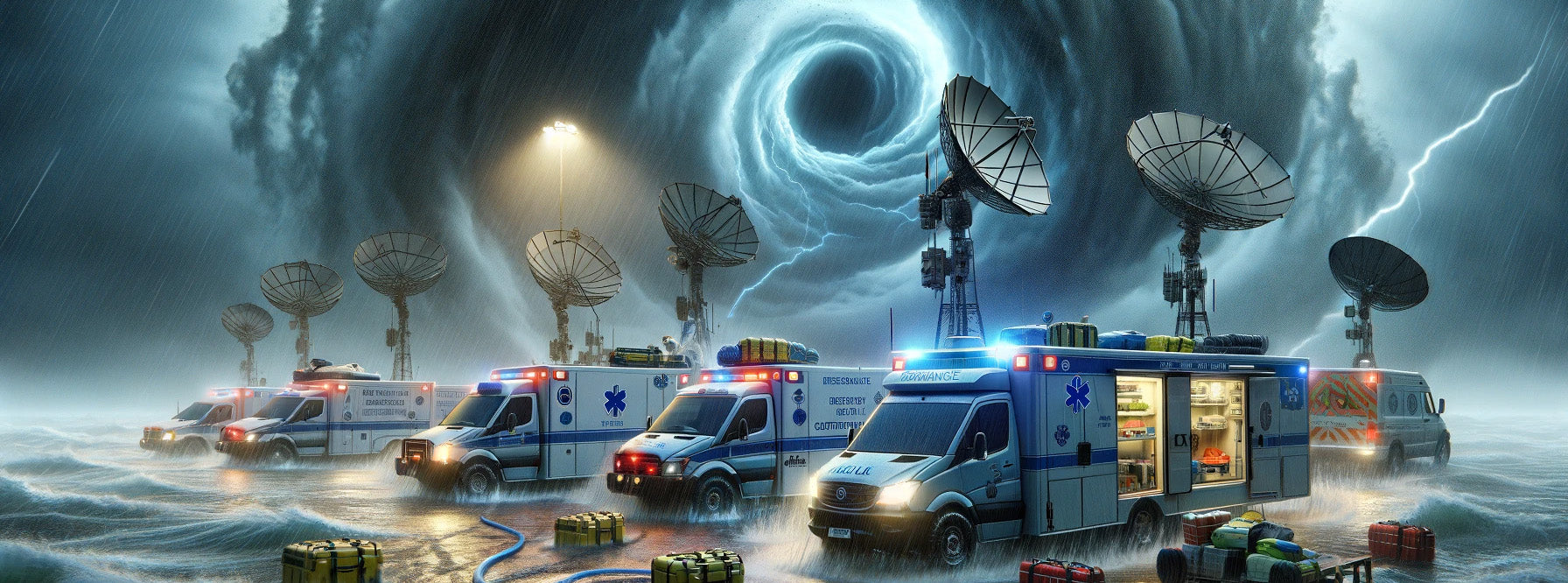
Emergency Communications and Satellite Networks
- 13 Mar, 2024
- Posted by: Michael Mathison
Emergency Communications and Satellite Networks
Satellite networks have revolutionized emergency communications by providing reliable, widespread connectivity that is crucial during disasters and crises. When terrestrial networks are compromised due to natural disasters, infrastructure failure, or other emergencies, satellite networks remain operational, ensuring that communication between first responders, emergency services, and affected populations is maintained.
This capability enables effective coordination of rescue operations, timely dissemination of information to the public, and rapid deployment of aid. Furthermore, satellite networks facilitate the gathering and transmission of critical data for disaster monitoring and response planning, significantly enhancing the efficiency and effectiveness of emergency management efforts. In this way, satellite networks serve as a vital backbone for emergency communications, ensuring resilience and support when it is most needed.

First Responders
Satellite networks have a profound impact on the operations and effectiveness of first responders, fundamentally transforming how they communicate, navigate, and respond to emergencies. Here’s how:
Explanation:
In the critical first moments of an emergency, reliable communication can mean the difference between life and death. Satellite networks provide first responders with robust communication links that are immune to the local infrastructure damages often caused by natural disasters or large-scale emergencies. This global coverage ensures that first responders can coordinate rescue efforts, receive real-time information, and access critical data no matter where the emergency unfolds.
Additionally, satellite technology enhances navigation and tracking, enabling responders to reach affected areas quickly and efficiently. The integration of satellite networks into emergency response systems supports advanced applications like real-time mapping, disaster monitoring, and telemedicine, further augmenting the capabilities of first responders in saving lives and mitigating the impacts of emergencies.
How First Responders are Affected by Satellite Networks:
-
Reliable Communication: Ensures uninterrupted communication when terrestrial networks are down, facilitating coordination and information sharing among emergency response teams.
-
Real-time Data Access: Provides access to up-to-date information on weather conditions, hazards, and emergency situations, enabling informed decision-making.
-
Enhanced Navigation and Tracking: Offers precise GPS data for navigation to emergency sites and tracking of personnel and assets in the field.
-
Disaster Monitoring and Assessment: Supports the use of satellite imagery for assessing disaster impacts, planning rescue operations, and monitoring ongoing emergencies.
-
Remote Area Operations: Enables communication and coordination for emergency responses in remote or inaccessible areas where traditional networks are unavailable.
-
Telemedicine: Facilitates the provision of medical advice and consultations via satellite communications, crucial for treating injuries in disaster-stricken areas before evacuation.
-
Search and Rescue Operations: Augments search and rescue efforts with satellite-based location tracking and communication, increasing the chances of finding and saving lives.
-
Public Warning Systems: Allows for the dissemination of emergency alerts and public safety information to a wide audience, regardless of their location.
-
Incident Command Support: Provides a reliable platform for establishing temporary command centers with full communication capabilities during major incidents.
-
Training and Simulation: Enhances training programs with satellite-based simulation tools, preparing first responders for a variety of emergency scenarios.
Satellite networks thus play an indispensable role in enhancing the operational effectiveness of first responders, ensuring they have the communication tools, data, and support needed to respond to emergencies rapidly and effectively.

Disaster Response and Relief
Satellite networks have become indispensable in enhancing the effectiveness of disaster response and relief operations, offering critical communication links and data services that are often vital in the aftermath of natural disasters or crises. Here’s how:
Explanation:
In disaster-stricken areas, where conventional communication infrastructure is often damaged or overwhelmed, satellite networks provide a reliable alternative for maintaining communication among first responders, relief organizations, and affected communities. These networks facilitate real-time coordination and information sharing, crucial for efficient and effective disaster response.
Additionally, satellite imagery and remote sensing technology play a key role in assessing disaster impacts, planning rescue and relief efforts, and monitoring recovery progress. The ability to access and share information rapidly across different locations and organizations greatly improves situational awareness, resource allocation, and the overall management of disaster response operations.
How Disaster Response and Relief Are Affected by Satellite Networks:
-
Reliable Communication: Ensure uninterrupted communication channels for emergency services, even when terrestrial networks are down.
-
Real-time Coordination: Enable coordination among various disaster response teams, government agencies, and non-governmental organizations (NGOs) for streamlined relief efforts.
-
Damage Assessment: Satellite imagery provides immediate assessments of disaster impact, helping to prioritize response efforts and identify areas in greatest need.
-
Navigation and Logistics: Support the logistics of delivering aid by providing accurate GPS navigation for relief vehicles in disrupted or unfamiliar terrain.
-
Resource Management: Facilitate the efficient allocation and tracking of resources and supplies, preventing duplication of efforts and ensuring aid reaches those who need it most.
-
Search and Rescue: Aid search and rescue operations by offering communication support and helping to locate survivors through GPS and satellite imagery.
-
Remote Medical Assistance: Connect remote or cut-off areas with medical professionals for telemedicine services, health advisories, and coordination of medical aid.
-
Monitoring and Early Warning: Satellite sensors contribute to monitoring environmental conditions and providing early warnings for potential hazards, reducing the risk of subsequent disasters.
-
Public Information and Alerts: Broadcast critical information and alerts to the public and disaster-affected communities, aiding in evacuation plans and safety measures.
-
Recovery and Reconstruction: Support long-term recovery and reconstruction efforts by monitoring progress, assessing ongoing needs, and ensuring continued coordination among involved parties.
Satellite networks thus play a crucial role in modern disaster response and relief efforts, providing the technology and services necessary to save lives, mitigate suffering, and support recovery in the wake of crises. Their ability to offer dependable communication and valuable data significantly enhances the capacity of response teams and organizations to meet the challenges of disaster management effectively.

Business Continuity
Satellite networks significantly bolster business continuity by ensuring reliable communication and data transfer capabilities, crucial during unexpected disruptions or disasters. By offering an independent communication infrastructure, satellite networks provide a resilient alternative to terrestrial networks that may be compromised by natural disasters, cyberattacks, or technical failures. Here’s how:
Explanation:
Businesses across various sectors rely on uninterrupted communication and data access to maintain operations, manage supply chains, and serve customers. Satellite networks facilitate this by providing global coverage, including remote and underserved areas, ensuring businesses can operate and communicate without reliance on ground-based infrastructure. In scenarios where traditional networks fail, satellite technology ensures that critical business functions continue, supporting everything from remote work capabilities to real-time data backup and recovery.
Furthermore, satellite networks enable businesses to implement comprehensive disaster recovery plans, enhancing their resilience and minimizing downtime. As businesses increasingly operate on a global scale, the role of satellite networks in ensuring continuous connectivity and safeguarding operations against unforeseen disruptions becomes increasingly vital.
How Business Continuity is Affected by Satellite Networks:
-
Uninterrupted Communication: Ensures continuous, reliable communication channels for internal and external stakeholders, crucial during network outages.
-
Global Coverage: Provides connectivity even in remote, hard-to-reach areas, supporting operations and workforce mobility worldwide.
-
Data Backup and Recovery: Facilitates secure, off-site data backup and swift recovery services via satellite links, crucial for protecting business data.
-
Disaster Recovery Support: Offers resilient infrastructure for implementing disaster recovery strategies, ensuring businesses can quickly resume operations after disruptions.
-
Remote Work Enablement: Supports remote work capabilities by providing reliable internet access, essential during emergencies that prevent access to physical offices.
-
Supply Chain Management: Enables real-time monitoring and management of supply chains, ensuring operational continuity even under challenging conditions.
-
Financial Transactions: Secures continued operation of financial systems and transactions, essential for business finance and e-commerce.
-
Customer Support: Maintains customer service and support channels, preserving customer relations and service continuity.
-
Operational Flexibility: Provides businesses with the flexibility to quickly adapt their operations in response to changing conditions.
-
Competitive Advantage: Enhances resilience and reliability, offering a competitive advantage in ensuring service continuity under all circumstances.
Satellite networks play a crucial role in supporting business continuity, offering solutions that ensure operations can withstand and quickly recover from disruptions. This technology not only aids in safeguarding against potential losses but also strengthens the overall resilience and reliability of businesses in a globally connected world.








